Managing People: Solving Generational Diversity Problems
VerifiedAdded on 2023/06/08
|14
|3148
|151
Report
AI Summary
This report identifies and analyzes the challenges of managing generational diversity in organizations, focusing on issues such as language and communication barriers, acceptance and respect, and generation gaps. It explores the managerial implications of these issues and provides both short-term and long-term solutions. Recommendations include establishing standard communication protocols, diversity training, referral schemes to foster acceptance, and strategies to bridge generation gaps. The report concludes by emphasizing the importance of creating an inclusive workplace culture to enhance team collaboration and organizational success. Desklib offers a wealth of resources, including similar solved assignments and past papers, to further support students in their studies.
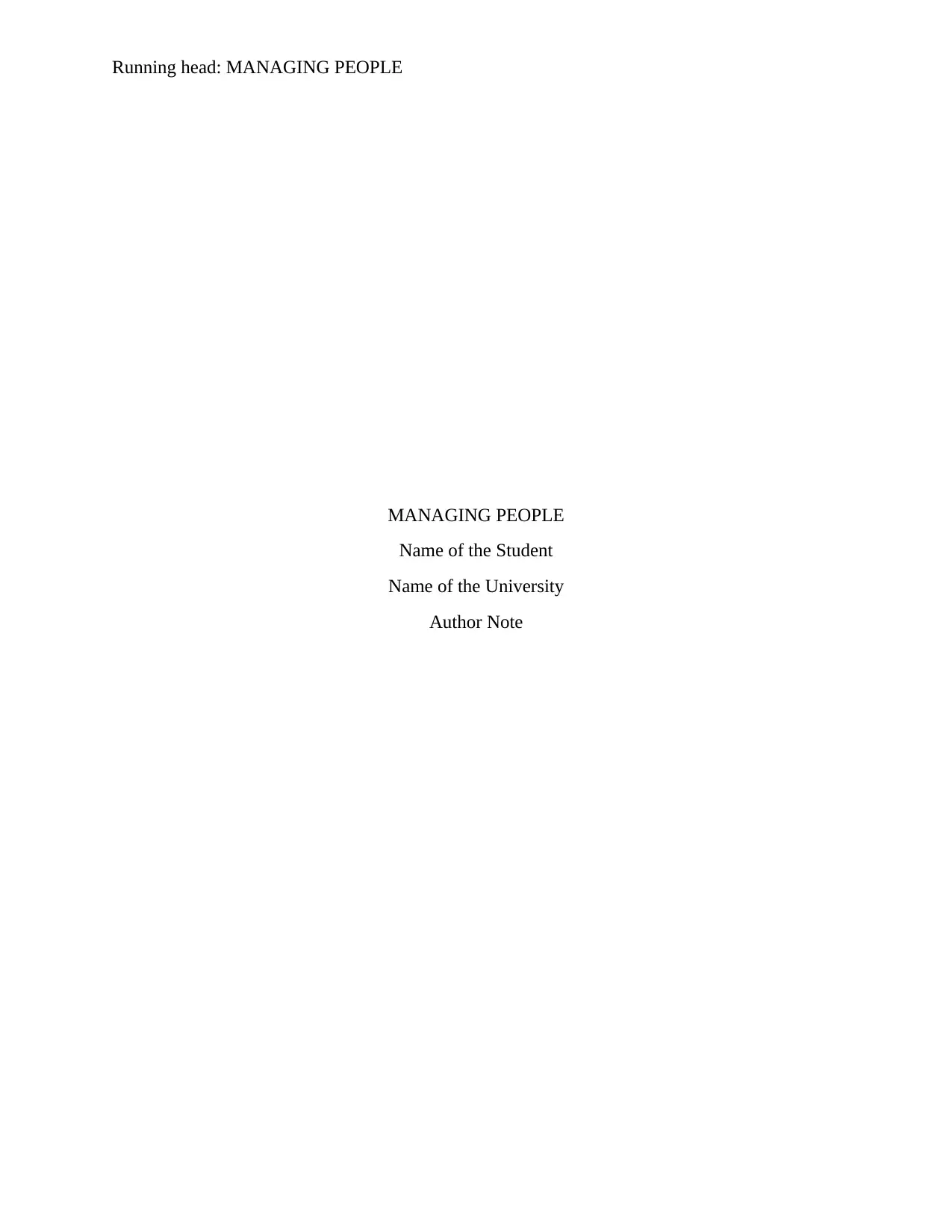
Running head: MANAGING PEOPLE
MANAGING PEOPLE
Name of the Student
Name of the University
Author Note
MANAGING PEOPLE
Name of the Student
Name of the University
Author Note
Paraphrase This Document
Need a fresh take? Get an instant paraphrase of this document with our AI Paraphraser
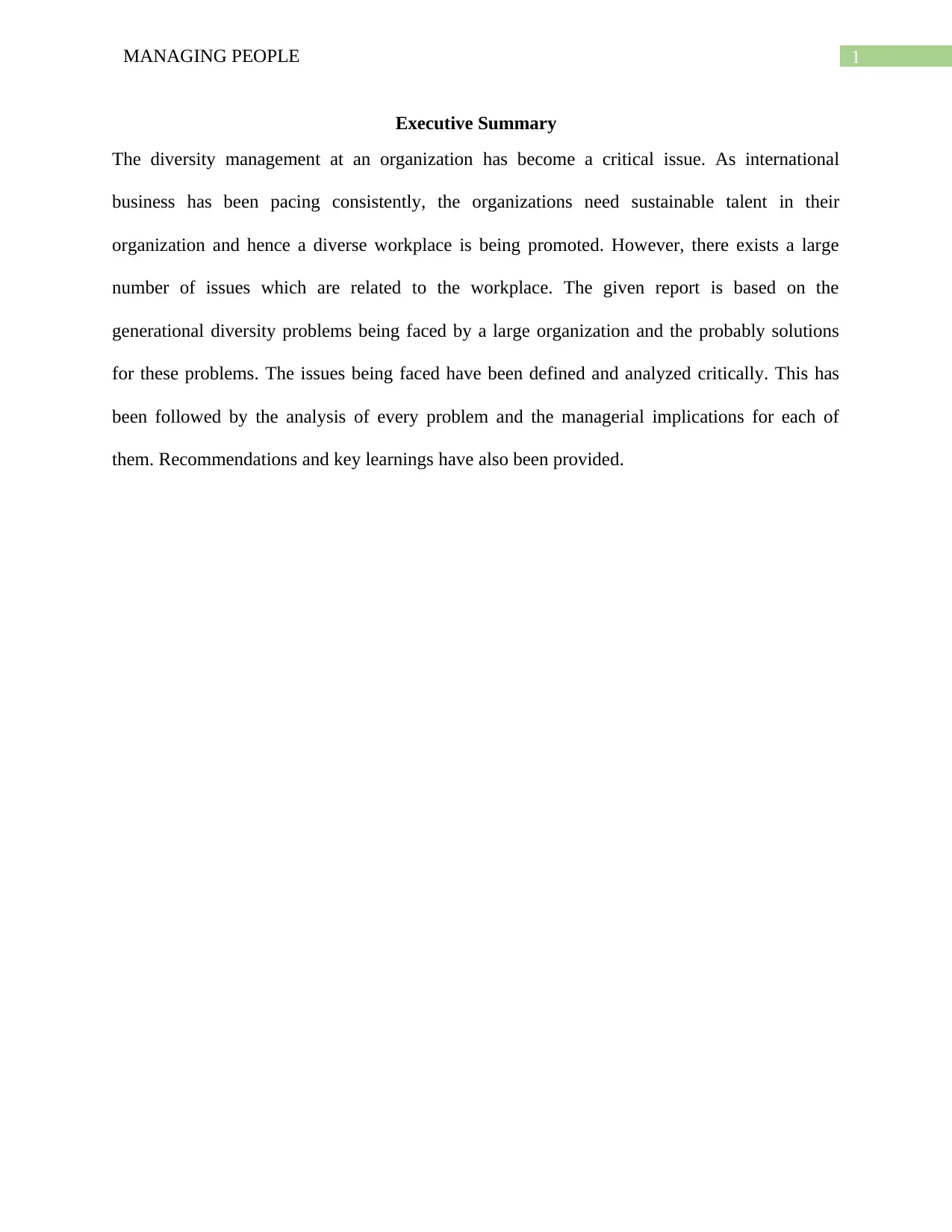
1MANAGING PEOPLE
Executive Summary
The diversity management at an organization has become a critical issue. As international
business has been pacing consistently, the organizations need sustainable talent in their
organization and hence a diverse workplace is being promoted. However, there exists a large
number of issues which are related to the workplace. The given report is based on the
generational diversity problems being faced by a large organization and the probably solutions
for these problems. The issues being faced have been defined and analyzed critically. This has
been followed by the analysis of every problem and the managerial implications for each of
them. Recommendations and key learnings have also been provided.
Executive Summary
The diversity management at an organization has become a critical issue. As international
business has been pacing consistently, the organizations need sustainable talent in their
organization and hence a diverse workplace is being promoted. However, there exists a large
number of issues which are related to the workplace. The given report is based on the
generational diversity problems being faced by a large organization and the probably solutions
for these problems. The issues being faced have been defined and analyzed critically. This has
been followed by the analysis of every problem and the managerial implications for each of
them. Recommendations and key learnings have also been provided.
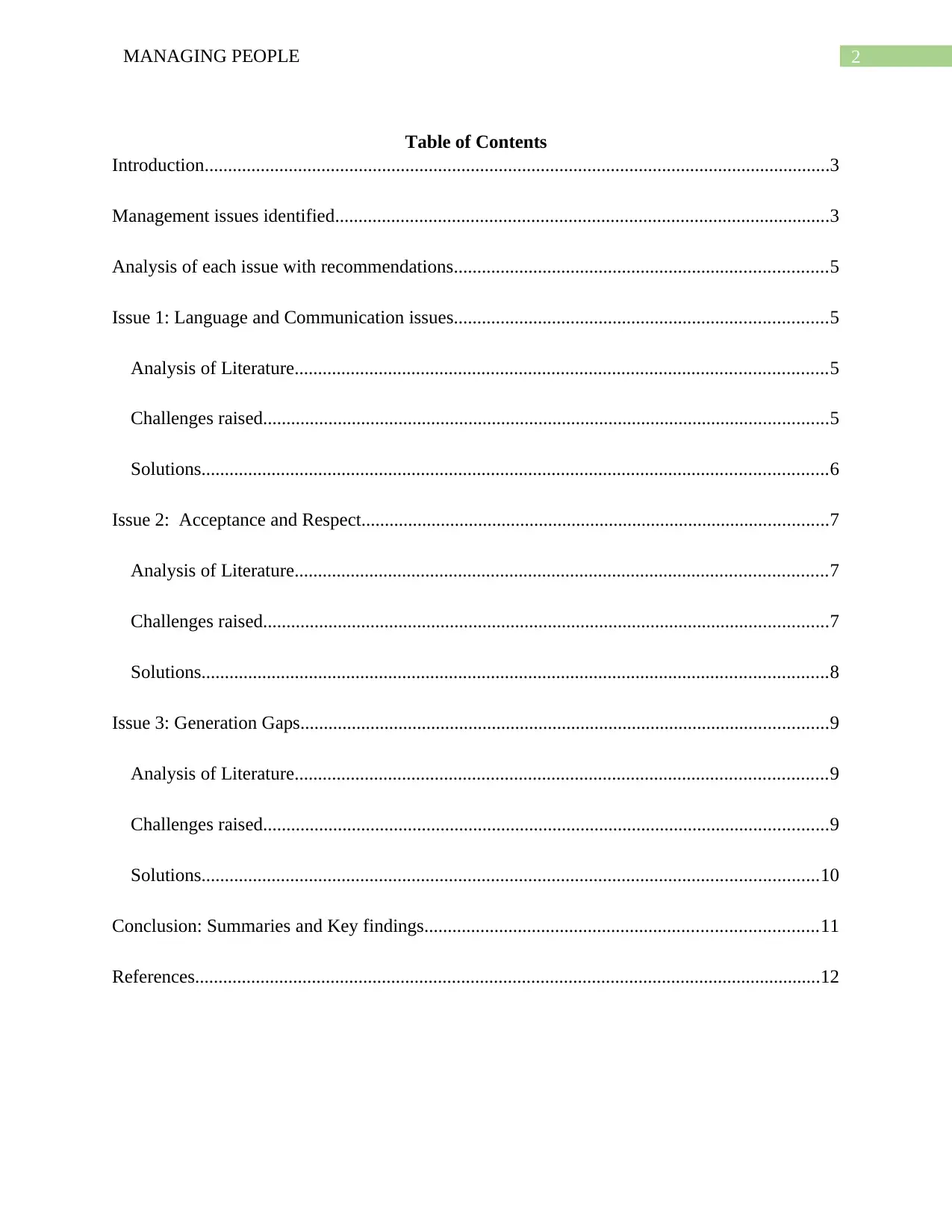
2MANAGING PEOPLE
Table of Contents
Introduction......................................................................................................................................3
Management issues identified..........................................................................................................3
Analysis of each issue with recommendations................................................................................5
Issue 1: Language and Communication issues................................................................................5
Analysis of Literature..................................................................................................................5
Challenges raised.........................................................................................................................5
Solutions......................................................................................................................................6
Issue 2: Acceptance and Respect....................................................................................................7
Analysis of Literature..................................................................................................................7
Challenges raised.........................................................................................................................7
Solutions......................................................................................................................................8
Issue 3: Generation Gaps.................................................................................................................9
Analysis of Literature..................................................................................................................9
Challenges raised.........................................................................................................................9
Solutions....................................................................................................................................10
Conclusion: Summaries and Key findings....................................................................................11
References......................................................................................................................................12
Table of Contents
Introduction......................................................................................................................................3
Management issues identified..........................................................................................................3
Analysis of each issue with recommendations................................................................................5
Issue 1: Language and Communication issues................................................................................5
Analysis of Literature..................................................................................................................5
Challenges raised.........................................................................................................................5
Solutions......................................................................................................................................6
Issue 2: Acceptance and Respect....................................................................................................7
Analysis of Literature..................................................................................................................7
Challenges raised.........................................................................................................................7
Solutions......................................................................................................................................8
Issue 3: Generation Gaps.................................................................................................................9
Analysis of Literature..................................................................................................................9
Challenges raised.........................................................................................................................9
Solutions....................................................................................................................................10
Conclusion: Summaries and Key findings....................................................................................11
References......................................................................................................................................12
⊘ This is a preview!⊘
Do you want full access?
Subscribe today to unlock all pages.

Trusted by 1+ million students worldwide
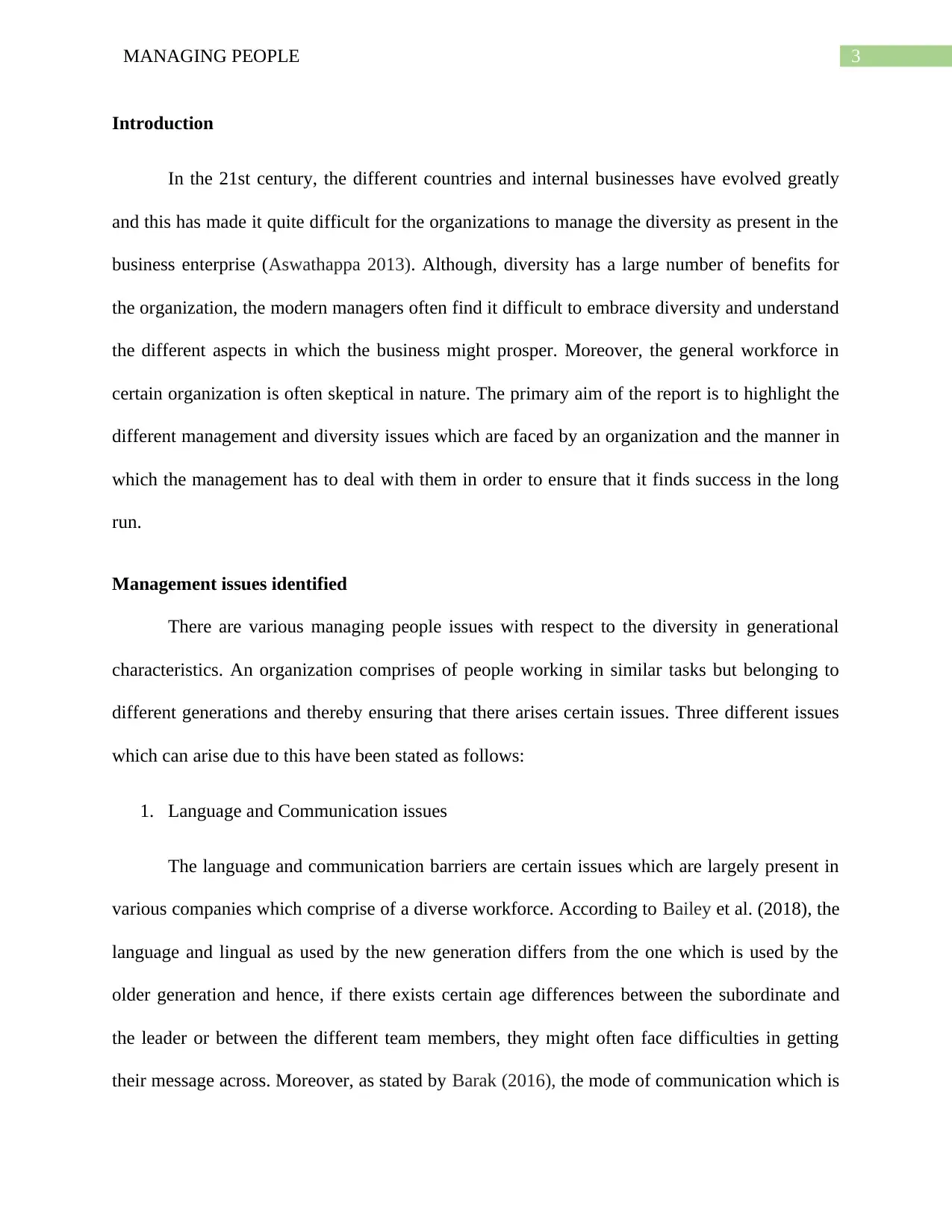
3MANAGING PEOPLE
Introduction
In the 21st century, the different countries and internal businesses have evolved greatly
and this has made it quite difficult for the organizations to manage the diversity as present in the
business enterprise (Aswathappa 2013). Although, diversity has a large number of benefits for
the organization, the modern managers often find it difficult to embrace diversity and understand
the different aspects in which the business might prosper. Moreover, the general workforce in
certain organization is often skeptical in nature. The primary aim of the report is to highlight the
different management and diversity issues which are faced by an organization and the manner in
which the management has to deal with them in order to ensure that it finds success in the long
run.
Management issues identified
There are various managing people issues with respect to the diversity in generational
characteristics. An organization comprises of people working in similar tasks but belonging to
different generations and thereby ensuring that there arises certain issues. Three different issues
which can arise due to this have been stated as follows:
1. Language and Communication issues
The language and communication barriers are certain issues which are largely present in
various companies which comprise of a diverse workforce. According to Bailey et al. (2018), the
language and lingual as used by the new generation differs from the one which is used by the
older generation and hence, if there exists certain age differences between the subordinate and
the leader or between the different team members, they might often face difficulties in getting
their message across. Moreover, as stated by Barak (2016), the mode of communication which is
Introduction
In the 21st century, the different countries and internal businesses have evolved greatly
and this has made it quite difficult for the organizations to manage the diversity as present in the
business enterprise (Aswathappa 2013). Although, diversity has a large number of benefits for
the organization, the modern managers often find it difficult to embrace diversity and understand
the different aspects in which the business might prosper. Moreover, the general workforce in
certain organization is often skeptical in nature. The primary aim of the report is to highlight the
different management and diversity issues which are faced by an organization and the manner in
which the management has to deal with them in order to ensure that it finds success in the long
run.
Management issues identified
There are various managing people issues with respect to the diversity in generational
characteristics. An organization comprises of people working in similar tasks but belonging to
different generations and thereby ensuring that there arises certain issues. Three different issues
which can arise due to this have been stated as follows:
1. Language and Communication issues
The language and communication barriers are certain issues which are largely present in
various companies which comprise of a diverse workforce. According to Bailey et al. (2018), the
language and lingual as used by the new generation differs from the one which is used by the
older generation and hence, if there exists certain age differences between the subordinate and
the leader or between the different team members, they might often face difficulties in getting
their message across. Moreover, as stated by Barak (2016), the mode of communication which is
Paraphrase This Document
Need a fresh take? Get an instant paraphrase of this document with our AI Paraphraser
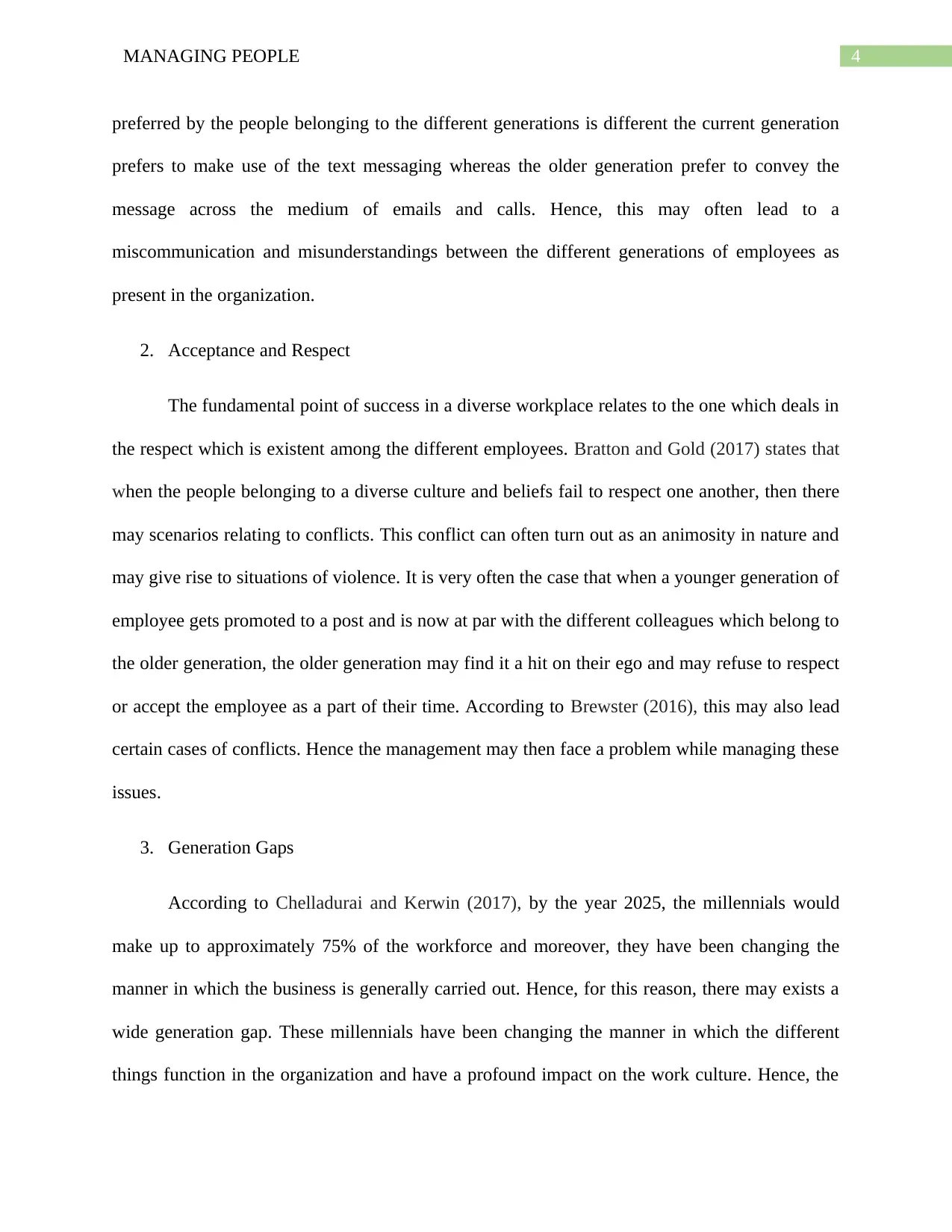
4MANAGING PEOPLE
preferred by the people belonging to the different generations is different the current generation
prefers to make use of the text messaging whereas the older generation prefer to convey the
message across the medium of emails and calls. Hence, this may often lead to a
miscommunication and misunderstandings between the different generations of employees as
present in the organization.
2. Acceptance and Respect
The fundamental point of success in a diverse workplace relates to the one which deals in
the respect which is existent among the different employees. Bratton and Gold (2017) states that
when the people belonging to a diverse culture and beliefs fail to respect one another, then there
may scenarios relating to conflicts. This conflict can often turn out as an animosity in nature and
may give rise to situations of violence. It is very often the case that when a younger generation of
employee gets promoted to a post and is now at par with the different colleagues which belong to
the older generation, the older generation may find it a hit on their ego and may refuse to respect
or accept the employee as a part of their time. According to Brewster (2016), this may also lead
certain cases of conflicts. Hence the management may then face a problem while managing these
issues.
3. Generation Gaps
According to Chelladurai and Kerwin (2017), by the year 2025, the millennials would
make up to approximately 75% of the workforce and moreover, they have been changing the
manner in which the business is generally carried out. Hence, for this reason, there may exists a
wide generation gap. These millennials have been changing the manner in which the different
things function in the organization and have a profound impact on the work culture. Hence, the
preferred by the people belonging to the different generations is different the current generation
prefers to make use of the text messaging whereas the older generation prefer to convey the
message across the medium of emails and calls. Hence, this may often lead to a
miscommunication and misunderstandings between the different generations of employees as
present in the organization.
2. Acceptance and Respect
The fundamental point of success in a diverse workplace relates to the one which deals in
the respect which is existent among the different employees. Bratton and Gold (2017) states that
when the people belonging to a diverse culture and beliefs fail to respect one another, then there
may scenarios relating to conflicts. This conflict can often turn out as an animosity in nature and
may give rise to situations of violence. It is very often the case that when a younger generation of
employee gets promoted to a post and is now at par with the different colleagues which belong to
the older generation, the older generation may find it a hit on their ego and may refuse to respect
or accept the employee as a part of their time. According to Brewster (2016), this may also lead
certain cases of conflicts. Hence the management may then face a problem while managing these
issues.
3. Generation Gaps
According to Chelladurai and Kerwin (2017), by the year 2025, the millennials would
make up to approximately 75% of the workforce and moreover, they have been changing the
manner in which the business is generally carried out. Hence, for this reason, there may exists a
wide generation gap. These millennials have been changing the manner in which the different
things function in the organization and have a profound impact on the work culture. Hence, the
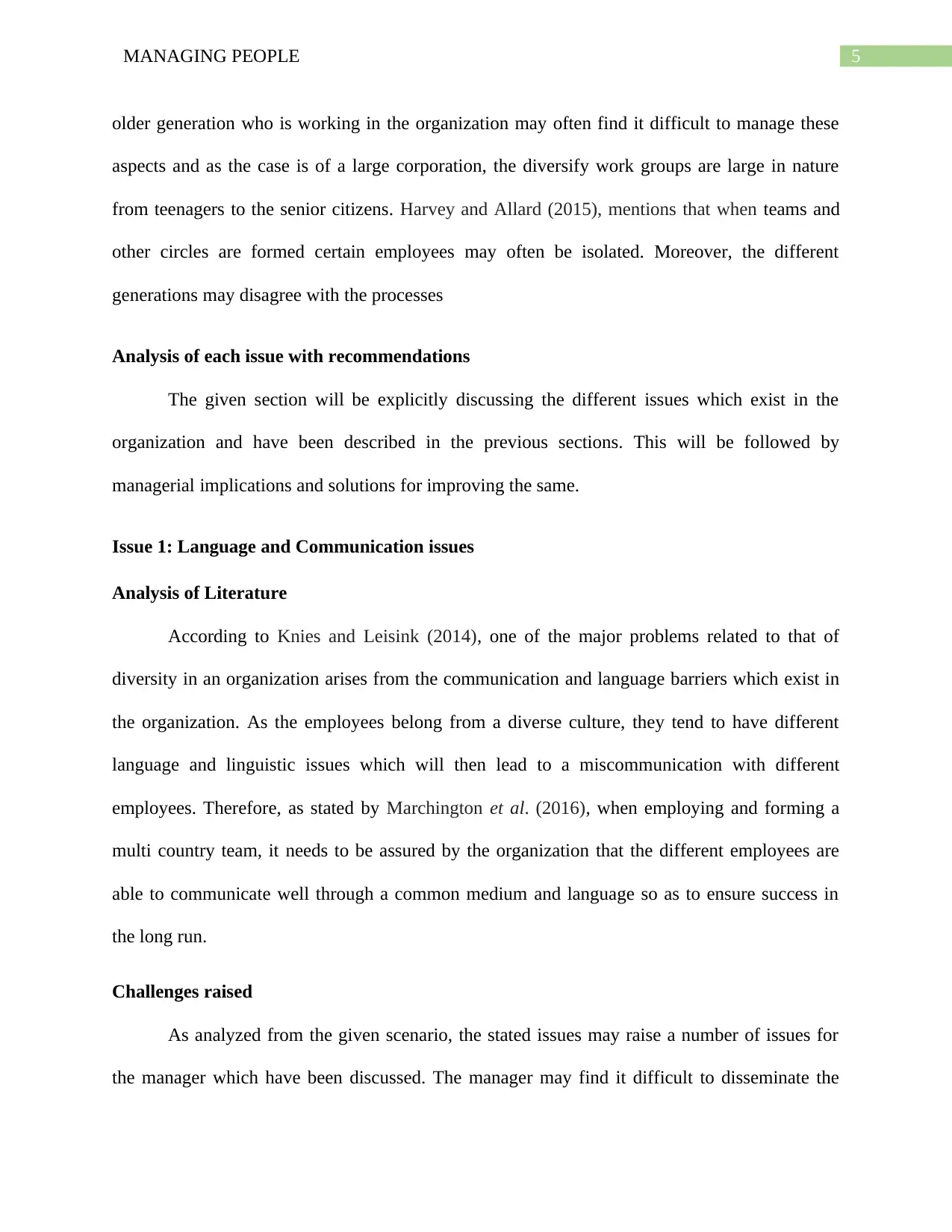
5MANAGING PEOPLE
older generation who is working in the organization may often find it difficult to manage these
aspects and as the case is of a large corporation, the diversify work groups are large in nature
from teenagers to the senior citizens. Harvey and Allard (2015), mentions that when teams and
other circles are formed certain employees may often be isolated. Moreover, the different
generations may disagree with the processes
Analysis of each issue with recommendations
The given section will be explicitly discussing the different issues which exist in the
organization and have been described in the previous sections. This will be followed by
managerial implications and solutions for improving the same.
Issue 1: Language and Communication issues
Analysis of Literature
According to Knies and Leisink (2014), one of the major problems related to that of
diversity in an organization arises from the communication and language barriers which exist in
the organization. As the employees belong from a diverse culture, they tend to have different
language and linguistic issues which will then lead to a miscommunication with different
employees. Therefore, as stated by Marchington et al. (2016), when employing and forming a
multi country team, it needs to be assured by the organization that the different employees are
able to communicate well through a common medium and language so as to ensure success in
the long run.
Challenges raised
As analyzed from the given scenario, the stated issues may raise a number of issues for
the manager which have been discussed. The manager may find it difficult to disseminate the
older generation who is working in the organization may often find it difficult to manage these
aspects and as the case is of a large corporation, the diversify work groups are large in nature
from teenagers to the senior citizens. Harvey and Allard (2015), mentions that when teams and
other circles are formed certain employees may often be isolated. Moreover, the different
generations may disagree with the processes
Analysis of each issue with recommendations
The given section will be explicitly discussing the different issues which exist in the
organization and have been described in the previous sections. This will be followed by
managerial implications and solutions for improving the same.
Issue 1: Language and Communication issues
Analysis of Literature
According to Knies and Leisink (2014), one of the major problems related to that of
diversity in an organization arises from the communication and language barriers which exist in
the organization. As the employees belong from a diverse culture, they tend to have different
language and linguistic issues which will then lead to a miscommunication with different
employees. Therefore, as stated by Marchington et al. (2016), when employing and forming a
multi country team, it needs to be assured by the organization that the different employees are
able to communicate well through a common medium and language so as to ensure success in
the long run.
Challenges raised
As analyzed from the given scenario, the stated issues may raise a number of issues for
the manager which have been discussed. The manager may find it difficult to disseminate the
⊘ This is a preview!⊘
Do you want full access?
Subscribe today to unlock all pages.

Trusted by 1+ million students worldwide
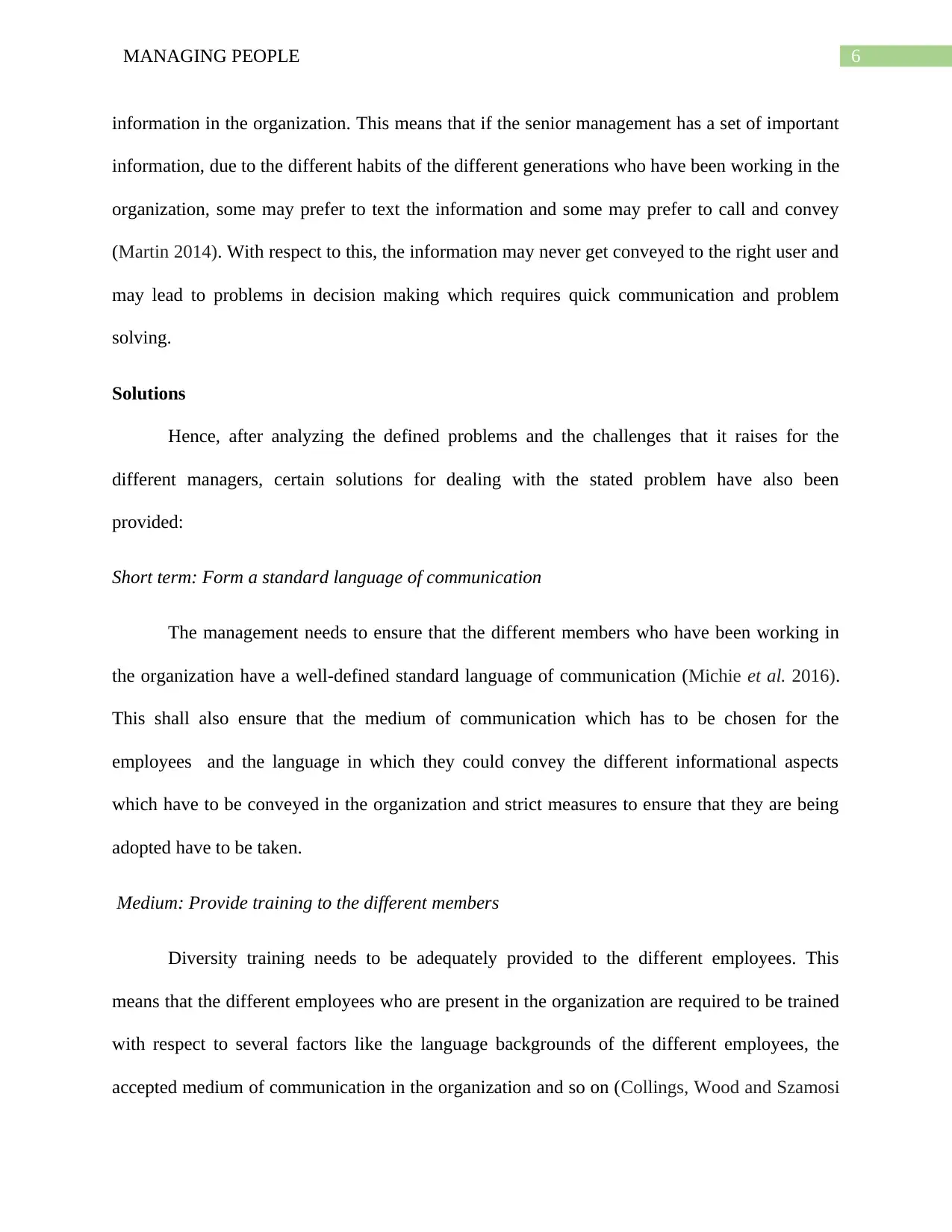
6MANAGING PEOPLE
information in the organization. This means that if the senior management has a set of important
information, due to the different habits of the different generations who have been working in the
organization, some may prefer to text the information and some may prefer to call and convey
(Martin 2014). With respect to this, the information may never get conveyed to the right user and
may lead to problems in decision making which requires quick communication and problem
solving.
Solutions
Hence, after analyzing the defined problems and the challenges that it raises for the
different managers, certain solutions for dealing with the stated problem have also been
provided:
Short term: Form a standard language of communication
The management needs to ensure that the different members who have been working in
the organization have a well-defined standard language of communication (Michie et al. 2016).
This shall also ensure that the medium of communication which has to be chosen for the
employees and the language in which they could convey the different informational aspects
which have to be conveyed in the organization and strict measures to ensure that they are being
adopted have to be taken.
Medium: Provide training to the different members
Diversity training needs to be adequately provided to the different employees. This
means that the different employees who are present in the organization are required to be trained
with respect to several factors like the language backgrounds of the different employees, the
accepted medium of communication in the organization and so on (Collings, Wood and Szamosi
information in the organization. This means that if the senior management has a set of important
information, due to the different habits of the different generations who have been working in the
organization, some may prefer to text the information and some may prefer to call and convey
(Martin 2014). With respect to this, the information may never get conveyed to the right user and
may lead to problems in decision making which requires quick communication and problem
solving.
Solutions
Hence, after analyzing the defined problems and the challenges that it raises for the
different managers, certain solutions for dealing with the stated problem have also been
provided:
Short term: Form a standard language of communication
The management needs to ensure that the different members who have been working in
the organization have a well-defined standard language of communication (Michie et al. 2016).
This shall also ensure that the medium of communication which has to be chosen for the
employees and the language in which they could convey the different informational aspects
which have to be conveyed in the organization and strict measures to ensure that they are being
adopted have to be taken.
Medium: Provide training to the different members
Diversity training needs to be adequately provided to the different employees. This
means that the different employees who are present in the organization are required to be trained
with respect to several factors like the language backgrounds of the different employees, the
accepted medium of communication in the organization and so on (Collings, Wood and Szamosi
Paraphrase This Document
Need a fresh take? Get an instant paraphrase of this document with our AI Paraphraser
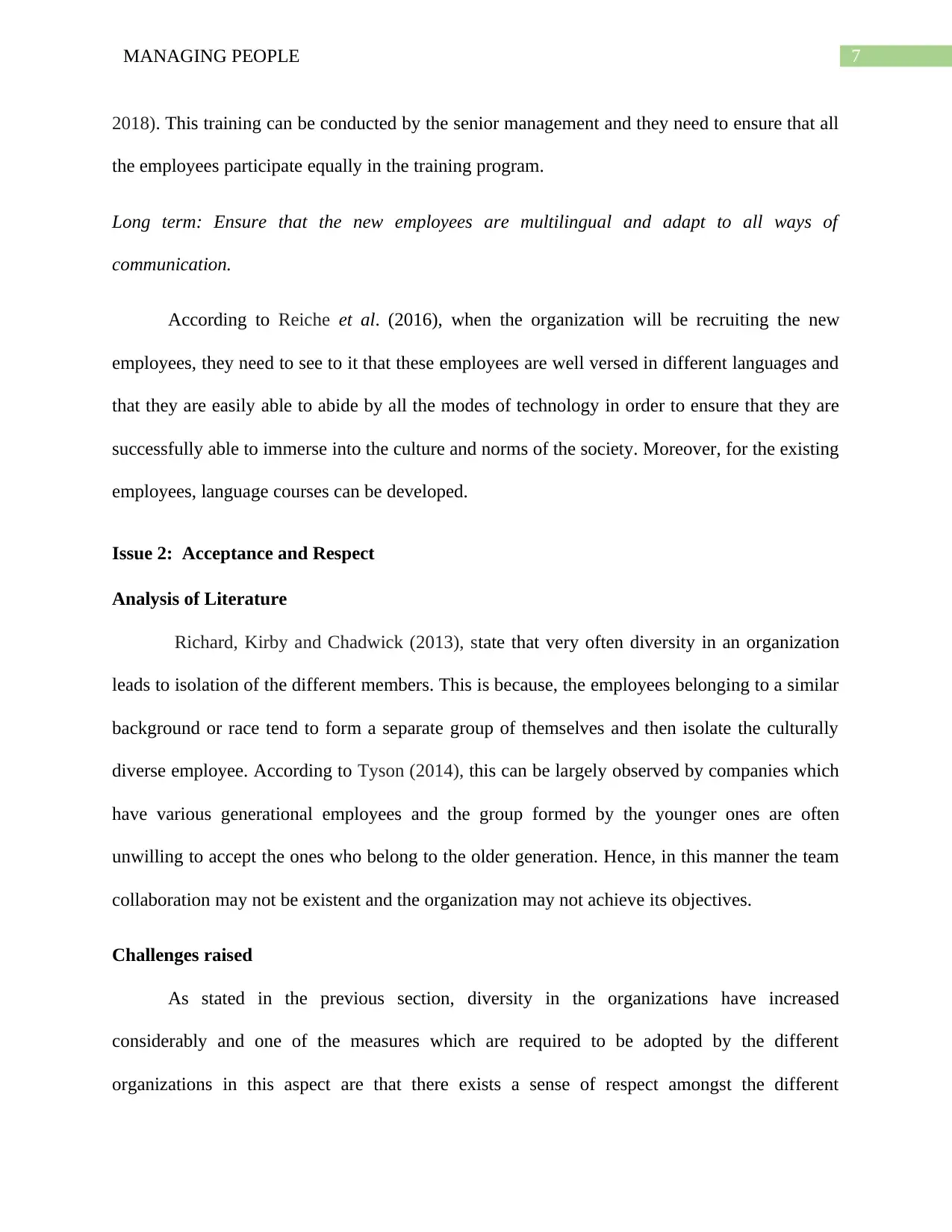
7MANAGING PEOPLE
2018). This training can be conducted by the senior management and they need to ensure that all
the employees participate equally in the training program.
Long term: Ensure that the new employees are multilingual and adapt to all ways of
communication.
According to Reiche et al. (2016), when the organization will be recruiting the new
employees, they need to see to it that these employees are well versed in different languages and
that they are easily able to abide by all the modes of technology in order to ensure that they are
successfully able to immerse into the culture and norms of the society. Moreover, for the existing
employees, language courses can be developed.
Issue 2: Acceptance and Respect
Analysis of Literature
Richard, Kirby and Chadwick (2013), state that very often diversity in an organization
leads to isolation of the different members. This is because, the employees belonging to a similar
background or race tend to form a separate group of themselves and then isolate the culturally
diverse employee. According to Tyson (2014), this can be largely observed by companies which
have various generational employees and the group formed by the younger ones are often
unwilling to accept the ones who belong to the older generation. Hence, in this manner the team
collaboration may not be existent and the organization may not achieve its objectives.
Challenges raised
As stated in the previous section, diversity in the organizations have increased
considerably and one of the measures which are required to be adopted by the different
organizations in this aspect are that there exists a sense of respect amongst the different
2018). This training can be conducted by the senior management and they need to ensure that all
the employees participate equally in the training program.
Long term: Ensure that the new employees are multilingual and adapt to all ways of
communication.
According to Reiche et al. (2016), when the organization will be recruiting the new
employees, they need to see to it that these employees are well versed in different languages and
that they are easily able to abide by all the modes of technology in order to ensure that they are
successfully able to immerse into the culture and norms of the society. Moreover, for the existing
employees, language courses can be developed.
Issue 2: Acceptance and Respect
Analysis of Literature
Richard, Kirby and Chadwick (2013), state that very often diversity in an organization
leads to isolation of the different members. This is because, the employees belonging to a similar
background or race tend to form a separate group of themselves and then isolate the culturally
diverse employee. According to Tyson (2014), this can be largely observed by companies which
have various generational employees and the group formed by the younger ones are often
unwilling to accept the ones who belong to the older generation. Hence, in this manner the team
collaboration may not be existent and the organization may not achieve its objectives.
Challenges raised
As stated in the previous section, diversity in the organizations have increased
considerably and one of the measures which are required to be adopted by the different
organizations in this aspect are that there exists a sense of respect amongst the different

8MANAGING PEOPLE
members. However, in case there is a lack of acceptance and respect for each other by the
various members of the organization then, the environment may turn out to be hostile (Brewster,
Chung and Sparrow 2016). Hence for the managers this may lead to complications relating to the
performance of the employees and lack of success in team management. If the different members
of a team are unable to gel with one another and are not able to successfully respond, they may
lack coordination which would then lead to a low production for the organization.
Solutions
After analyzing the different problems, certain recommendations shall be provided as
follows:
Short term: Team meetings and collaboration
For this purpose, the senior management is required to engage into various meetings as
well as collaboration meets whereby it ensures that the different members are well introduced to
one another and that they are able to coordinate with one another. According to Harvey and
Allard (2015), if the senior management is successful in fostering an environment which tends to
support the different cultures, they automatically set an example for the different members to do
the same.
Medium Provide training
For this aspect too, adequate training needs to be provided to the different employees. In
this training the importance of diversification needs to be highlighted and a roadmap should be
formed which will assist in the identification of the fact and the manner in which the
organization shall improve considerably when adopting this system (Knies and Leisink 2014).
Hence, the employees will be made to understand that they are the key members of the firm and
members. However, in case there is a lack of acceptance and respect for each other by the
various members of the organization then, the environment may turn out to be hostile (Brewster,
Chung and Sparrow 2016). Hence for the managers this may lead to complications relating to the
performance of the employees and lack of success in team management. If the different members
of a team are unable to gel with one another and are not able to successfully respond, they may
lack coordination which would then lead to a low production for the organization.
Solutions
After analyzing the different problems, certain recommendations shall be provided as
follows:
Short term: Team meetings and collaboration
For this purpose, the senior management is required to engage into various meetings as
well as collaboration meets whereby it ensures that the different members are well introduced to
one another and that they are able to coordinate with one another. According to Harvey and
Allard (2015), if the senior management is successful in fostering an environment which tends to
support the different cultures, they automatically set an example for the different members to do
the same.
Medium Provide training
For this aspect too, adequate training needs to be provided to the different employees. In
this training the importance of diversification needs to be highlighted and a roadmap should be
formed which will assist in the identification of the fact and the manner in which the
organization shall improve considerably when adopting this system (Knies and Leisink 2014).
Hence, the employees will be made to understand that they are the key members of the firm and
⊘ This is a preview!⊘
Do you want full access?
Subscribe today to unlock all pages.

Trusted by 1+ million students worldwide

9MANAGING PEOPLE
that it is very important for these members to corporate with the organization and help it to
achieve success in the long run.
Long term: Referral scheme to ensure acceptance exists
If the different employees who belong to the same organization are known to one, then it
becomes comparatively easier. However, a solution to the problem is that each employee is
asked to make referrals as to the posts in an organization (Martin 2014). These people may
belong to different age groups and genders but they may not be of the same age. In this manner,
acceptance from the side of the existing employees shall become comparatively easier for the
employees and lead to the long term objective fulfillment.
Issue 3: Generation Gaps
Analysis of Literature
Chelladurai and Kerwin (2017), states that around 75% of the organizational population
will be covered by the millennials by 2025. it can thereby be stated that at the same organization
different age group members will be present. It is often not possible for these members to gel
adequately with one another and this can be contributed to the difference in thought procedures
of these different generations. Brewster, Chung and Sparrow (2016), believes that these
differences in though procedures tend to have an impact on the decision making and goal
achievement.
Challenges raised
When their exists generation gaps between the different members of the workforce then,
the manager may then face difficulties as to making the different organizational members gel
with one another. For an organization to become successful in nature, there needs to be a similar
that it is very important for these members to corporate with the organization and help it to
achieve success in the long run.
Long term: Referral scheme to ensure acceptance exists
If the different employees who belong to the same organization are known to one, then it
becomes comparatively easier. However, a solution to the problem is that each employee is
asked to make referrals as to the posts in an organization (Martin 2014). These people may
belong to different age groups and genders but they may not be of the same age. In this manner,
acceptance from the side of the existing employees shall become comparatively easier for the
employees and lead to the long term objective fulfillment.
Issue 3: Generation Gaps
Analysis of Literature
Chelladurai and Kerwin (2017), states that around 75% of the organizational population
will be covered by the millennials by 2025. it can thereby be stated that at the same organization
different age group members will be present. It is often not possible for these members to gel
adequately with one another and this can be contributed to the difference in thought procedures
of these different generations. Brewster, Chung and Sparrow (2016), believes that these
differences in though procedures tend to have an impact on the decision making and goal
achievement.
Challenges raised
When their exists generation gaps between the different members of the workforce then,
the manager may then face difficulties as to making the different organizational members gel
with one another. For an organization to become successful in nature, there needs to be a similar
Paraphrase This Document
Need a fresh take? Get an instant paraphrase of this document with our AI Paraphraser
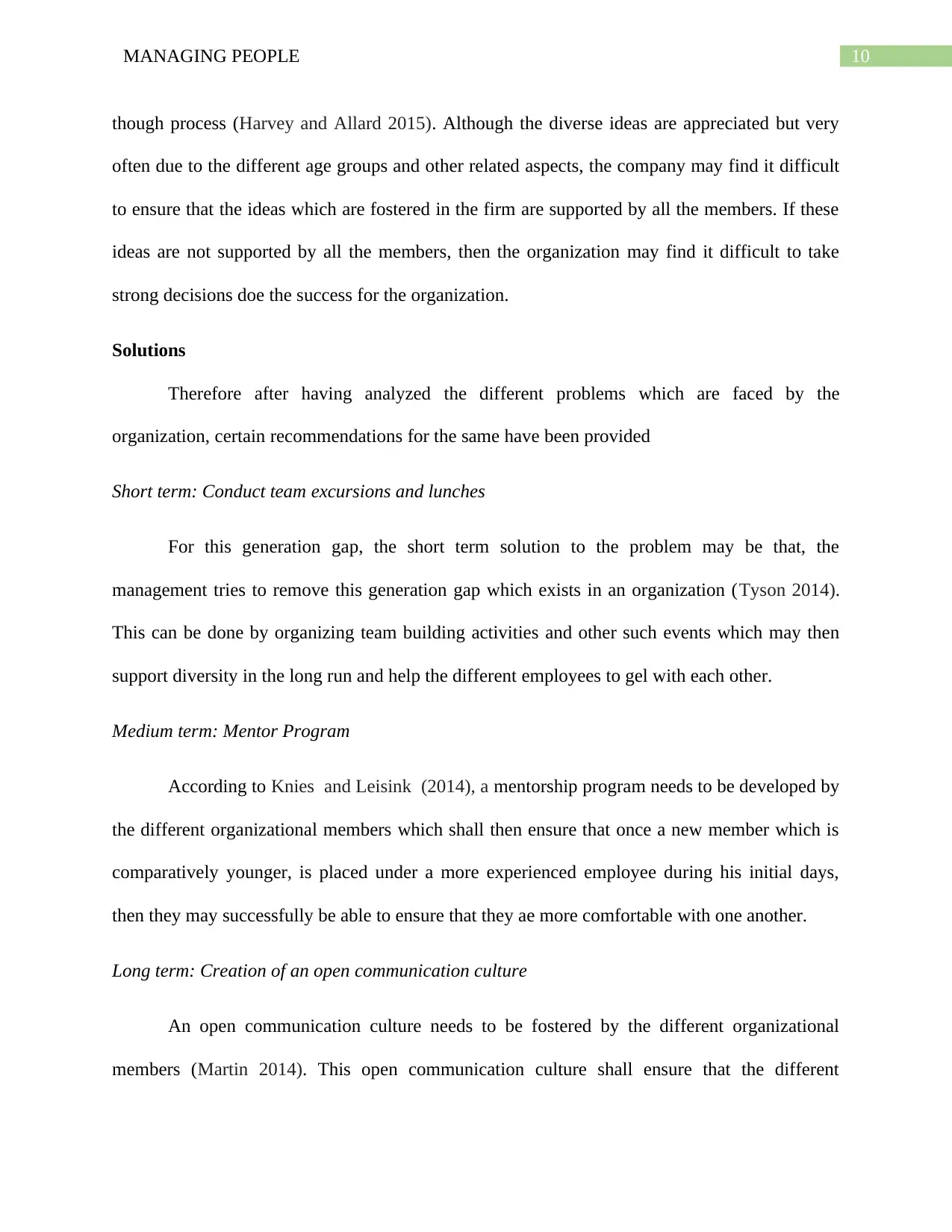
10MANAGING PEOPLE
though process (Harvey and Allard 2015). Although the diverse ideas are appreciated but very
often due to the different age groups and other related aspects, the company may find it difficult
to ensure that the ideas which are fostered in the firm are supported by all the members. If these
ideas are not supported by all the members, then the organization may find it difficult to take
strong decisions doe the success for the organization.
Solutions
Therefore after having analyzed the different problems which are faced by the
organization, certain recommendations for the same have been provided
Short term: Conduct team excursions and lunches
For this generation gap, the short term solution to the problem may be that, the
management tries to remove this generation gap which exists in an organization (Tyson 2014).
This can be done by organizing team building activities and other such events which may then
support diversity in the long run and help the different employees to gel with each other.
Medium term: Mentor Program
According to Knies and Leisink (2014), a mentorship program needs to be developed by
the different organizational members which shall then ensure that once a new member which is
comparatively younger, is placed under a more experienced employee during his initial days,
then they may successfully be able to ensure that they ae more comfortable with one another.
Long term: Creation of an open communication culture
An open communication culture needs to be fostered by the different organizational
members (Martin 2014). This open communication culture shall ensure that the different
though process (Harvey and Allard 2015). Although the diverse ideas are appreciated but very
often due to the different age groups and other related aspects, the company may find it difficult
to ensure that the ideas which are fostered in the firm are supported by all the members. If these
ideas are not supported by all the members, then the organization may find it difficult to take
strong decisions doe the success for the organization.
Solutions
Therefore after having analyzed the different problems which are faced by the
organization, certain recommendations for the same have been provided
Short term: Conduct team excursions and lunches
For this generation gap, the short term solution to the problem may be that, the
management tries to remove this generation gap which exists in an organization (Tyson 2014).
This can be done by organizing team building activities and other such events which may then
support diversity in the long run and help the different employees to gel with each other.
Medium term: Mentor Program
According to Knies and Leisink (2014), a mentorship program needs to be developed by
the different organizational members which shall then ensure that once a new member which is
comparatively younger, is placed under a more experienced employee during his initial days,
then they may successfully be able to ensure that they ae more comfortable with one another.
Long term: Creation of an open communication culture
An open communication culture needs to be fostered by the different organizational
members (Martin 2014). This open communication culture shall ensure that the different

11MANAGING PEOPLE
organizational members, are comfortable with one another and the age gap differences do not
bring a barrier to their operations
Conclusion: Summaries and Key findings
Therefore, from the given analysis, three different problems which are generally faced by
the large organizations with respect to generational diversity have been provided. These
problems related to the problems relating to language and communication, generation gap and
acceptance with respect. Each problem has been analyzed effectively with respect to relevant
literature and the solutions have been recommended.
organizational members, are comfortable with one another and the age gap differences do not
bring a barrier to their operations
Conclusion: Summaries and Key findings
Therefore, from the given analysis, three different problems which are generally faced by
the large organizations with respect to generational diversity have been provided. These
problems related to the problems relating to language and communication, generation gap and
acceptance with respect. Each problem has been analyzed effectively with respect to relevant
literature and the solutions have been recommended.
⊘ This is a preview!⊘
Do you want full access?
Subscribe today to unlock all pages.

Trusted by 1+ million students worldwide
1 out of 14
Related Documents
Your All-in-One AI-Powered Toolkit for Academic Success.
+13062052269
info@desklib.com
Available 24*7 on WhatsApp / Email
![[object Object]](/_next/static/media/star-bottom.7253800d.svg)
Unlock your academic potential
Copyright © 2020–2025 A2Z Services. All Rights Reserved. Developed and managed by ZUCOL.





